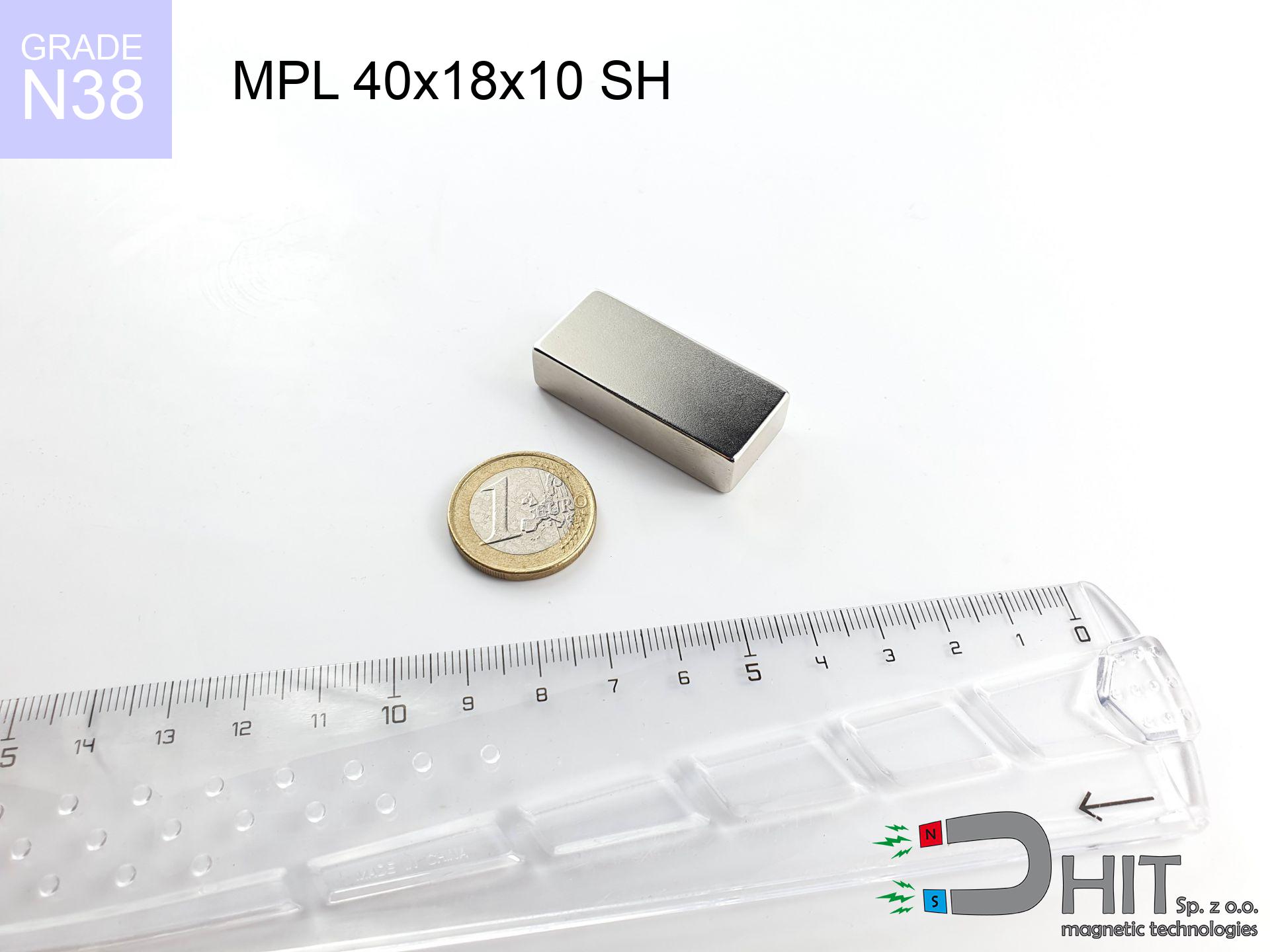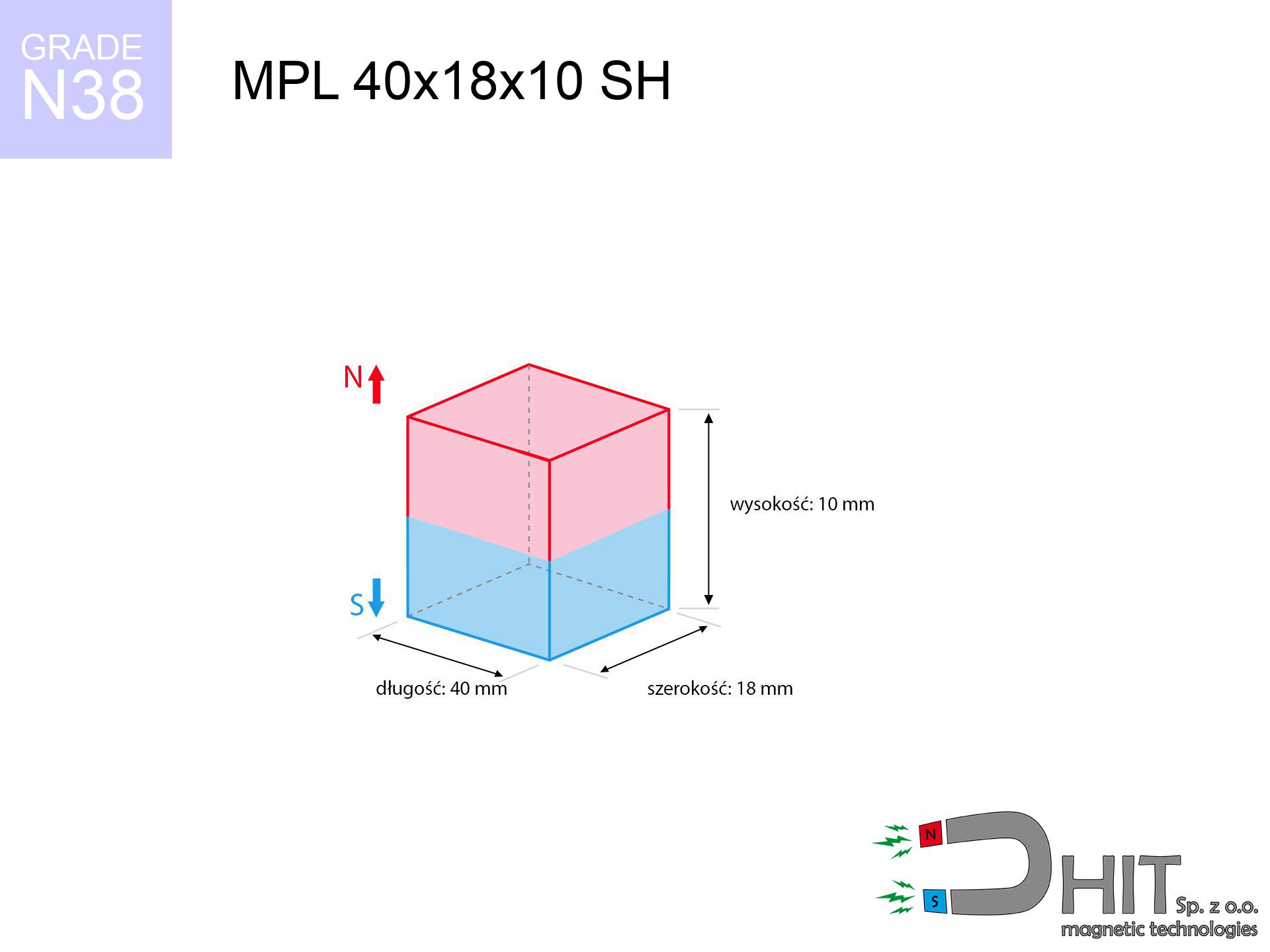MPL 40x18x10 SH / N38 - neodymium magnet
lamellar magnet
catalog number 020157
GTIN: 5906301811633
length
40
mm [±0,1 mm]
width
18
mm [±0,1 mm]
height
10
mm [±0,1 mm]
magnetizing direction
↑ axial
magnetic induction ~
366.66 mT / 3,667 Gs
max. temperature
≤ 80
°C
catalog number 020157
GTIN: 5906301811633
length
40 mm [±0,1 mm]
width
18 mm [±0,1 mm]
height
10 mm [±0,1 mm]
magnetizing direction
↑ axial
magnetic induction ~
366.66 mT / 3,667 Gs
max. temperature
≤ 80 °C
33.83 ZŁ gross price (including VAT) / pcs +
27.50 ZŁ net price + 23% VAT / pcs
bulk discounts:
need more quantity?Don't know what to choose?
Call us tel: +48 22 499 98 98 or contact us through form on our website. You can check the strength as well as the shape of neodymium magnets in our magnetic mass calculator magnetic calculator
Orders placed by 2:00 PM will be shipped on the same business day.
Specification: lamellar magnet 40x18x10 SH / N38 ↑ axial
Magnetic properties of the material N38
Physical properties of sintered neodymium magnets Nd2Fe14B
Due to their strength, flat magnets are regularly used in products that need exceptional adhesion.
Most common temperature resistance of these magnets is 80 °C, but with larger dimensions, this value can increase.
Additionally, flat magnets commonly have special coatings applied to their surfaces, e.g. nickel, gold, or chrome, to increase their strength.
The magnet named MPL 40x18x10 SH / N38 i.e. a magnetic force 0.00 kg which weighs only 54.00 grams, making it the excellent choice for projects needing a flat magnet.
Contact surface: Due to their flat shape, flat magnets guarantee a greater contact surface with adjacent parts, which is beneficial in applications requiring a stronger magnetic connection.
Technology applications: These magnets are often used in various devices, such as sensors, stepper motors, or speakers, where the thin and wide shape is crucial for their operation.
Mounting: Their flat shape makes mounting, especially when there's a need to attach the magnet to another surface.
Design flexibility: The flat shape of the magnets gives the possibility designers greater flexibility in placing them in devices, which can be more difficult with magnets of other shapes.
Stability: In certain applications, the flat base of the flat magnet may provide better stability, reducing the risk of shifting or rotating. However, one should remember that the optimal shape of the magnet is dependent on the specific project and requirements. In certain cases, other shapes, like cylindrical or spherical, are a better choice.
Magnets have two poles: north (N) and south (S), which interact with each other when they are oppositely oriented. Poles of the same kind, e.g. two north poles, act repelling on each other.
Thanks to this principle of operation, magnets are commonly used in magnetic technologies, such as motors, speakers, sensors, or magnetic locks. Neodymium magnets stand out with the greatest strength of attraction, making them perfect for applications requiring powerful magnetic fields. Moreover, the strength of a magnet depends on its size and the material it is made of.
It’s worth noting that high temperatures can weaken the magnet's effect. Every magnetic material has its Curie point, meaning that once this temperature is exceeded, the magnet stops being magnetic. Interestingly, strong magnets can interfere with the operation of devices, such as navigational instruments, credit cards and even electronic devices sensitive to magnetic fields. For this reason, it is important to avoid placing magnets near such devices.
Find suggested articles
Advantages as well as disadvantages of neodymium magnets NdFeB.
In addition to immense strength, neodymium magnets have the following advantages:
- They do not lose power over time. After 10 years, their strength decreases by only ~1% (theoretically),
- They are exceptionally resistant to demagnetization caused by an external magnetic field,
- In other words, thanks to the shiny coating of nickel, gold, or silver, the element acquires an aesthetic appearance,
- They possess very high magnetic induction on the surface of the magnet,
- Thanks to their high temperature resistance, they can operate (depending on the shape) even at temperatures up to 230°C and above...
- Thanks to the flexibility in shaping and the ability to adapt to specific requirements – neodymium magnets can be produced in various forms and dimensions, which enhances their versatility in applications.
- Key role in the industry of new technologies – find application in computer drives, electric drive mechanisms, medical equipment and very advanced devices.
Disadvantages of neodymium magnets:
- They can break as they are extremely fragile when subjected to a powerful impact. If the magnets are exposed to impacts, we recommend using magnets in a metal holder. The steel housing in the form of a holder protects the magnet from impacts and also increases its overall strength,
- Magnets lose their power due to exposure to high temperatures. In most cases, when the temperature exceeds 80°C, these magnets experience permanent loss in strength (although it is worth noting that this is dependent on the shape and size of the magnet). To avoid this problem, we offer special magnets marked with the [AH] symbol, which exhibit high temperature resistance. They can operate even at temperatures as high as 230°C or more,
- Magnets exposed to a humid environment can corrode. Therefore, when using them outdoors, we suggest using waterproof magnets made of rubber, plastic, or other moisture-resistant materials,
- The use of a cover - a magnetic holder is recommended due to the limited production capabilities of creating threads or complex shapes in the magnet
- Health risk to health from tiny fragments of magnets can be dangerous, if swallowed, which is particularly important in the context of child safety. Furthermore, tiny parts of these products are able to hinder the diagnostic process in case of swallowing.
Handle with Care: Neodymium Magnets
Dust and powder from neodymium magnets are highly flammable.
Do not attempt to drill into neodymium magnets. Mechanical processing is also not recommended. Once crushed into fine powder or dust, this material becomes highly flammable.
Magnets made of neodymium are highly delicate, they easily fall apart as well as can become damaged.
In the event of a collision between two neodymium magnets, it can result in them getting chipped. Despite being made of metal as well as coated with a shiny nickel plating, they are not as hard as steel. At the moment of connection between the magnets, small sharp metal fragments can be propelled in various directions at high speed. Eye protection is recommended.
It is important to maintain neodymium magnets away from youngest children.
Not all neodymium magnets are toys, so do not let children play with them. In such a situation, surgery is necessary to remove them. In the worst case scenario, it can result in death.
Neodymium magnets are over 10 times stronger than ferrite magnets (the ones in speakers), and their strength can surprise you.
Read the information on our website on how to properly utilize neodymium magnets and avoid significant harm to your body and unintentional disruption to the magnets.
Avoid bringing neodymium magnets close to a phone or GPS.
Intense magnetic fields generated by neodymium magnets interfere with compasses and magnetometers used in navigation, as well as internal compasses of smartphones and GPS devices.
Keep neodymium magnets away from TV, wallet, and computer HDD.
The strong magnetic field generated by neodymium magnets can destroy magnetic media such as floppy disks, video tapes, HDDs, credit cards, magnetic ID cards, cassette tapes, etc. devices. They can also damage devices like video players, televisions, CRT computer monitors. Remember not to place neodymium magnets close to these electronic devices.
Neodymium magnets can demagnetize at high temperatures.
Even though magnets have been observed to maintain their efficacy up to temperatures of 80°C or 175°F, it's essential to consider that this threshold may fluctuate depending on the magnet's type, configuration, and intended usage.
Neodymium magnets can attract to each other, pinch the skin, and cause significant swellings.
Neodymium magnets bounce and also touch each other mutually within a radius of several to almost 10 cm from each other.
People with pacemakers are advised to avoid neodymium magnets.
Neodymium magnets produce strong magnetic fields that can interfere with the operation of a heart pacemaker. However, if the magnetic field does not affect the device, it can damage its components or deactivate the device when it is in a magnetic field.
The magnet coating contains nickel, so be cautious if you have a nickel allergy.
Studies clearly indicate a small percentage of people who suffer from metal allergies such as nickel. An allergic reaction often manifests as skin redness and rash. If you have a nickel allergy, try wearing gloves or avoid direct contact with nickel-plated neodymium magnets.
In order for you to know how strong neodymium magnets are and why they are so dangerous, see the article - Dangerous strong neodymium magnets.




![magnetic holder internal thread 60x30x15 [M10] GW / N38 magnetic holder internal thread 60x30x15 [M10] GW / N38](https://cdn3.dhit.pl/graphics/products/umgw-60x30x15-m10-gw-cug.jpg)




